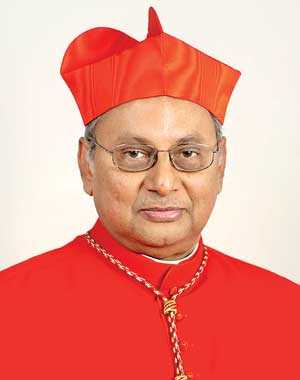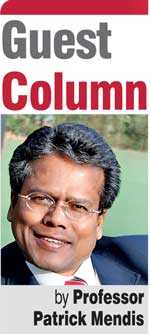Sunday Mar 16, 2025
Sunday Mar 16, 2025
Monday, 29 October 2018 00:07 - - {{hitsCtrl.values.hits}}
Given the gravity of the crises facing the Vatican, it has wasted no-time in redefining the moral mission of the Catholic Church in the world.
Yet, the American federal investigation into the sexual improprieties of clergies in Pennsylvania—as well as a warming Vatican pivot toward atheist China—has, in fact, provided an opportunity for the papal leadership in the Holy See.
What lies beneath the two debates in the United States and China? And, why?
Human rights as a religion
An insightful yet contentious perspective comes from the unlikely and predominantly Buddhist nation of Sri Lanka that has historical connections to China, the United States, and the Vatican. 
At a recent mass in the St. Matthew’s Catholic Church near Colombo, His Eminent Cardinal Malcolm Ranjith of Sri Lanka said that “human rights have become the new religion of the West as if it’s a new discovery, but people in our country have been following religions (e.g., Buddhism, Christianity, Hinduism, and Islam) for centuries. . . It is those who are not following any religion who talk about all these human rights issues.”
For over two millennia, Buddhism co-existed with the late arrival of other religions in Sri Lanka. In the fifth century, for example, the archaeological evidence of the “Anuradhapura Cross” suggests that a vibrant Catholic community lived in the capital city of Anuradhapura, where the resident Chinese scholar-monk Faxian (Fa-Hsien) once witnessed Buddhist rituals while Arab, Indian, and other merchants and pilgrims traveling on the Silk Road exchanged ideas and goods for spiritual and material development.
Critics may misconstrue Cardinal Ranjith’s basic argument, but he believes that Buddhist teachings are harmonious with those human rights concepts of the West and the dignity of human life in the Catholic social teachings.
For the cardinal, every major religion endorses human rights but Buddhism resolves conflict and reconciles human rights violations on individual basis without an external agency or an imposing power. That is, the Buddhist Dhamma (teachings in Pali) has the most enlightened and logical framework in the intrinsic nature of human sustenance and the eternal continuity (Samsaric journey in Buddhism) of individual person.
Misconstrued reality in America
Contrary to America’s founding notion of “all men are created equal” with “unalienable rights,” the Buddha provided the Immutable Law of Nature that each person’s individual Karma (or Kamma in Pali) drives the cause and effect in human behaviour and destiny—not an external power “endowed by their Creator” or “Nature’s God.” Thus, Thomas Jefferson’s famous American motto, “life, liberty, and the pursuit of happiness” is simply aspirational—but not grounded in truth and reality of the nature of things.
Jeffersonian liberty—by its extension freedom—was also initially constructed for the pursuit of wealth, but later changed to happiness, i.e., spiritual happiness. The true happiness in Buddhist Dhamma is meant freedom from desire, not freedom of desire for a happy life.
When the UN Universal Declaration of Human Rights was drafted in 1948, it extended the American vision of reality—not as a universal reality.
In the Buddhist reality, the no-self (or, no soul or Anatta in Pali) is the universal reality that the self no longer exists; therefore, there is no individual rights because the person does not exist. What remains is a process from the birth to death that is governed by the Law of Kamma. In his core teachings embedded in the Law of Dependent Origination (Paticca Samuppada in Pali), the Buddha elaborated the Doctrine of Kamma that has its own mechanism of rewards and punishments from this world to the other—as the life or the soul is eternal until it reaches its Anatta or the freedom of desire, i.e., ending human suffering or attaining Nirvana (Nibbana in Pali).

Searching for universal values
When Cardinal Ranjith spoke of Buddhism and human rights as interchangeable as a religion, he underscored the elements of Buddhist teachings that has sustained a harmonious civilization that has existed in Sri Lanka.
Seemingly for the cardinal, “all human beings are born free and equal in dignity and rights,” as expressed in the Article one of the Universal Declaration. Indeed, it is as an accurate statement, as each person—man or woman equally—has the individual power to reach Buddhahood or attain Nibbana (or Anatta). In fact, the Buddha taught that each person—with his or her own efforts—can achieve ultimate happiness without gender, creed, caste, or any other social constructs.
The cardinal apparently envisions that Buddhism surpasses the Declaration because the Buddha included the animals and other sentient materials to be respected as their mutual interdependence would sustain humanity. This is essential for each person to journey in the Samsaric (eternal) life.
The question of human rights in China
Hence, there is no enforcing authority or an external agency to govern a person, individually or collectively. In an increasingly Confucian society of hierarchy in China, the issues related to human rights are even more problematic as the Chinese think more of themselves as a collective entity.
The power relations between state and subject, father and son, husband and wife, and other status-related affairs are predicated on achieving social order—not freedom from desire, or suppression. In the Sigalovada Sutta, the Buddhist reciprocal relations—as rights and duties—are respected and mutually supported as equal between husband and wife, teacher and student, and state and subject.
For a Buddhist, the Five Precepts—i.e., all common to every major religious tradition—and the Noble Eightfold Path are the self-governing mechanisms that prevent oneself from killing, stealing, sexual impropriety, hatred, and delusion. In the Veludvara Sutta, the Buddha said that “one should not do anything to others that one does not like done to oneself,” which is universally now known as the Golden Rule.
Occasional self-reflection
The centrality of Buddhism is its ethics of non-violence. The pursuit of material happiness with freedom of desire did not propel the United States toward achieving its proclaimed rights for women, African-Americans, and the Native Americans until their own struggles for the Women Suffrage, Civil Rights, and the voting and land rights began.
The Confucian China is still struggling with the recognition of self-determination of Tibetans, Uighurs, and other minorities and religious groups. As the Communist Party of China has seemingly portraited its success in governing domestic affairs, its promotion of Confucius Institutes and Chinese values has now been pushed back by the United States, Australia, and other countries by alleging Beijing’s “sharp power” and influence operation industry.
Altogether for a shared destiny, the problem of the United States and China is that the former does not want to remember its history, especially for the “cause of liberty” in the American Revolutionary War. And, the latter does not want to forget the Chinese history, particularly for the “cause of freedom” from the memories of the Century of Humiliation under the colonial powers.
This is not to discount the history of the Catholic Church and its dark chapters of the past and present. Yet, Cardinal Ranjith highlights the importance of justice in humanity. Whether it is the Doctrine of Kamma or universal ethics rooted in Buddhism, it is critical to have occasional self-reflections for healthy discourse.
Indeed, it is better to think of the status of our world differently than that which we inherited, because “the arc of the moral universe is long, but it bends toward justice,” as Martin Luther King Jr. once observed.
(Professor Patrick Mendis is a distinguished visiting professor of Sino-American relations at the Yenching Academy of Peking University. An American commissioner for UNESCO, he is a former Rajawali senior fellow of the Ash Center for Democratic Governance and Innovation at the Harvard Kennedy School and a research associate of the Fairbank Center for Chinese Studies at Harvard University. The opinions expressed here are his own and do not represent the institutions of his affiliation in the past or present.)
Discover Kapruka, the leading online shopping platform in Sri Lanka, where you can conveniently send Gifts and Flowers to your loved ones for any event including Valentine ’s Day. Explore a wide range of popular Shopping Categories on Kapruka, including Toys, Groceries, Electronics, Birthday Cakes, Fruits, Chocolates, Flower Bouquets, Clothing, Watches, Lingerie, Gift Sets and Jewellery. Also if you’re interested in selling with Kapruka, Partner Central by Kapruka is the best solution to start with. Moreover, through Kapruka Global Shop, you can also enjoy the convenience of purchasing products from renowned platforms like Amazon and eBay and have them delivered to Sri Lanka.
Discover Kapruka, the leading online shopping platform in Sri Lanka, where you can conveniently send Gifts and Flowers to your loved ones for any event including Valentine ’s Day. Explore a wide range of popular Shopping Categories on Kapruka, including Toys, Groceries, Electronics, Birthday Cakes, Fruits, Chocolates, Flower Bouquets, Clothing, Watches, Lingerie, Gift Sets and Jewellery. Also if you’re interested in selling with Kapruka, Partner Central by Kapruka is the best solution to start with. Moreover, through Kapruka Global Shop, you can also enjoy the convenience of purchasing products from renowned platforms like Amazon and eBay and have them delivered to Sri Lanka.